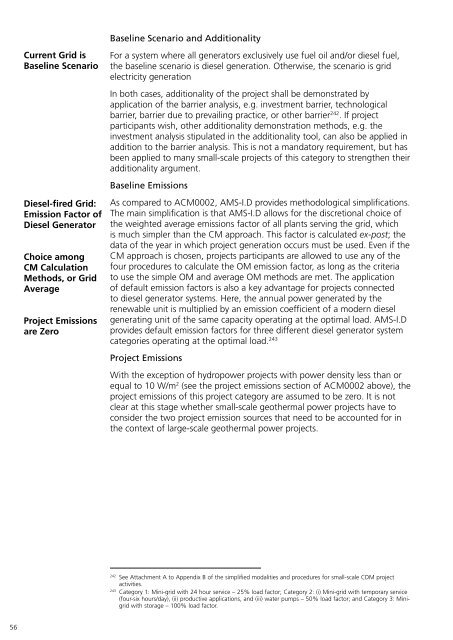Understanding CDM Methodologies - SuSanA
Understanding CDM Methodologies - SuSanA
Understanding CDM Methodologies - SuSanA
You also want an ePaper? Increase the reach of your titles
YUMPU automatically turns print PDFs into web optimized ePapers that Google loves.
Baseline Scenario and Additionality<br />
Current Grid is<br />
Baseline Scenario<br />
Diesel-fired Grid:<br />
Emission Factor of<br />
Diesel Generator<br />
Choice among<br />
CM Calculation<br />
Methods, or Grid<br />
Average<br />
Project Emissions<br />
are Zero<br />
For a system where all generators exclusively use fuel oil and/or diesel fuel,<br />
the baseline scenario is diesel generation. Otherwise, the scenario is grid<br />
electricity generation<br />
In both cases, additionality of the project shall be demonstrated by<br />
application of the barrier analysis, e.g. investment barrier, technological<br />
barrier, barrier due to prevailing practice, or other barrier 242 . If project<br />
participants wish, other additionality demonstration methods, e.g. the<br />
investment analysis stipulated in the additionality tool, can also be applied in<br />
addition to the barrier analysis. This is not a mandatory requirement, but has<br />
been applied to many small-scale projects of this category to strengthen their<br />
additionality argument.<br />
Baseline Emissions<br />
As compared to ACM0002, AMS-I.D provides methodological simplifications.<br />
The main simplification is that AMS-I.D allows for the discretional choice of<br />
the weighted average emissions factor of all plants serving the grid, which<br />
is much simpler than the CM approach. This factor is calculated ex-post; the<br />
data of the year in which project generation occurs must be used. Even if the<br />
CM approach is chosen, projects participants are allowed to use any of the<br />
four procedures to calculate the OM emission factor, as long as the criteria<br />
to use the simple OM and average OM methods are met. The application<br />
of default emission factors is also a key advantage for projects connected<br />
to diesel generator systems. Here, the annual power generated by the<br />
renewable unit is multiplied by an emission coefficient of a modern diesel<br />
generating unit of the same capacity operating at the optimal load. AMS-I.D<br />
provides default emission factors for three different diesel generator system<br />
categories operating at the optimal load. 243<br />
Project Emissions<br />
With the exception of hydropower projects with power density less than or<br />
equal to 10 W/m 2 (see the project emissions section of ACM0002 above), the<br />
project emissions of this project category are assumed to be zero. It is not<br />
clear at this stage whether small-scale geothermal power projects have to<br />
consider the two project emission sources that need to be accounted for in<br />
the context of large-scale geothermal power projects.<br />
242<br />
See Attachment A to Appendix B of the simplified modalities and procedures for small-scale <strong>CDM</strong> project<br />
activities.<br />
243<br />
Category 1: Mini-grid with 24 hour service – 25% load factor; Category 2: (i) Mini-grid with temporary service<br />
(four-six hours/day), (ii) productive applications, and (iii) water pumps – 50% load factor; and Category 3: Minigrid<br />
with storage – 100% load factor.<br />
56

















